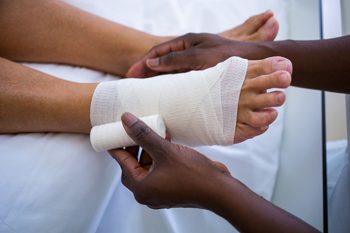 Diabetic patients are often aware that a common area for wounds to develop is on the feet. This may be a result of elevated glucose levels in the blood, which can cause nerve damage. The nerve damage can result in difficulty feeling cuts, bruises, and wounds on the feet. Proper wound care consists of washing the affected area, followed by applying an antibiotic ointment. The wound can be protected by covering it with a bandage, which can also help to control drainage. The healing process may possibly be accelerated by keeping weight off of the affected foot, which can be achieved by wearing an offloading boot. If you are afflicted with wounds on your feet, it is strongly recommended that you are under the care of a podiatrist who can guide you toward the best treatments for you.
Diabetic patients are often aware that a common area for wounds to develop is on the feet. This may be a result of elevated glucose levels in the blood, which can cause nerve damage. The nerve damage can result in difficulty feeling cuts, bruises, and wounds on the feet. Proper wound care consists of washing the affected area, followed by applying an antibiotic ointment. The wound can be protected by covering it with a bandage, which can also help to control drainage. The healing process may possibly be accelerated by keeping weight off of the affected foot, which can be achieved by wearing an offloading boot. If you are afflicted with wounds on your feet, it is strongly recommended that you are under the care of a podiatrist who can guide you toward the best treatments for you.
Wound care is an important part in dealing with diabetes. If you have diabetes and a foot wound or would like more information about wound care for diabetics, consult with Dr. Michael D. Garvin from Florida. Our doctor will assess your condition and provide you with quality foot and ankle treatment.
What Is Wound Care?
Wound care is the practice of taking proper care of a wound. This can range from the smallest to the largest of wounds. While everyone can benefit from proper wound care, it is much more important for diabetics. Diabetics often suffer from poor blood circulation which causes wounds to heal much slower than they would in a non-diabetic.
What Is the Importance of Wound Care?
While it may not seem apparent with small ulcers on the foot, for diabetics, any size ulcer can become infected. Diabetics often also suffer from neuropathy, or nerve loss. This means they might not even feel when they have an ulcer on their foot. If the wound becomes severely infected, amputation may be necessary. Therefore, it is of the upmost importance to properly care for any and all foot wounds.
How to Care for Wounds
The best way to care for foot wounds is to prevent them. For diabetics, this means daily inspections of the feet for any signs of abnormalities or ulcers. It is also recommended to see a podiatrist several times a year for a foot inspection. If you do have an ulcer, run the wound under water to clear dirt from the wound; then apply antibiotic ointment to the wound and cover with a bandage. Bandages should be changed daily and keeping pressure off the wound is smart. It is advised to see a podiatrist, who can keep an eye on it.
If you have any questions, please feel free to contact our offices located in Port St. Lucie, FL . We offer the newest diagnostic and treatment technologies for all your foot care needs.
